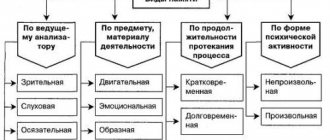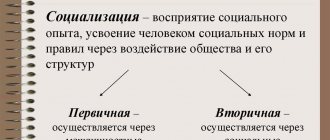Memory is the most important function of the human brain, used in mental operations and necessary for composing new facts with familiar information. Any personal characteristics are directly related to a person’s experience, which cannot be accumulated without memory. Without it, it is impossible to adapt to a changing environment.
Short-term memory depends on the brain
Every year more and more information enters the human brain, it is necessary to be able to analyze it. For this purpose, there is short-term memory, which is used in any mental work. Understanding the principles of memory functioning will help you use and develop it more effectively.
What is short-term memory
A simple definition is this: short-term (working) memory is a function of the human brain, the task of which is to retain the necessary information for a short time.
It is impossible to consider short-term memory in isolation from sensory and long-term memory. When a person sees or hears something, the first type of memory works for him. Sensory memory stores information for a few seconds while the nerve signal is stored in neurons. But then the old information is quickly replaced by new information, which the person perceived through the senses.
Visualizing memory in the brain
Example. If you look at a motionless person for a long time, the eye will remember his silhouette. Sensory memory differs from short-term memory in that the first works only at the moment an object impacts a person’s senses, and in the second, information is still retained for an hour.
There is also long-term memory. As the name suggests, it stores data for a long time.
Information can come into short-term memory from both sensory and long-term memory. Another name for the type of memory discussed in this article is active; a person directly uses it in any intellectual activity.
Short-term and long-term memory are closely related: the longer information is retained in the head, the higher the likelihood of it being stored in long-term memory.
Volume
Volume is a characteristic indicating the maximum amount of information that can be stored in short-term memory at any given moment.
How much data can the human brain hold? It is generally accepted that the capacity of short-term memory is 7+/-2 units or blocks of information. This was discovered by the famous scientist George Miller.
As learning progresses, units of information are combined into blocks. For example, turning a car on the road consists of reducing speed, turning the steering wheel in one line, and at the end of the maneuver - in another. A beginner keeps each action in this sequence separately, so a simpler task requires more RAM.
Short-term memory in the human head
Each of these actions takes up at least three cells in a person’s RAM. But as training progresses, they are all executed quickly and begin to occupy one cell. This is why experienced drivers manage to talk on the phone and drive at the same time. They have to process only two blocks of information at the same time.
True, in a non-standard situation, the amount of data in RAM increases sharply (there are many unfamiliar pieces of information), and, if we speak at this time, the probability of an accident increases sharply. Therefore, you should not talk on the phone while driving, even if it seems that you can control the situation on the road. Unforeseen situations arise regularly; while driving, the entire amount of RAM must be available for driving. The ability to effectively drive a vehicle lies in the ability to concentrate as much as possible on the road, keeping all its objects in short-term memory.
Attention! The amount of RAM can be less than 5 units. Everything is very conditional. It is necessary to take into account the specifics of the data being remembered, the person’s condition, motivation and other parameters.
Types of short-term memory
Short-term memory is divided into several types, based on how it is encoded.
Sound (auditory)
Information comes through the organ of hearing. For it to register, it is not enough just to hear. It is important to speak the information out loud or repeat it silently. Otherwise, the received information will disappear after 30 seconds.
Visual (visual)
Information comes through the organ of vision. To transfer a picture from the level of short-term memory to long-term memory, it is necessary to carry out phonological coding - say several times what a person sees (out loud or silently), select associations for what he saw.
Kinesthetic (tactile)
The process of memorization through tactile sensations. This type of memory does not actively work in all people. Kinesthetic learners must touch a thing, hold it in their hands, feel its warmth or cold, surface texture, weight in order to assimilate and consolidate information about it.
People with well-developed auditory memory easily reproduce heard information. To integrate new information into memory, visual learners must see it in the form of drawings, diagrams, notes. Practical work and experiments help kinesthetic learners remember information.
Possible problems and violations
Phenomenal memory - what is it, methods for developing information memorization
Every person's memory is far from perfect. Therefore, everyone has various problems and dysfunctions of this function. Possible violations:
- Violation of consolidation. Information is not transferred from short-term storage to long-term storage. There are many reasons: lack of sleep, insufficient logical processing of incoming information, illness, hunger, and also ignorance of the mechanisms of memory.
- Impaired entry of information into short-term memory. May occur due to inattention or lack of sleep.
- Diseases. Problems occur both with a common cold (although not so significant) and with serious diseases (Pick's disease, Alzheimer's disease, brain oncology).
These problems may go away over time or get worse.
Problems at a young age
Memory tends to be better at a young age. But disorders can also occur in young people.
Students studying
The reasons are universal for any age; the following can be added to those described above:
- Fatigue. The problems are especially aggravated for students during the session. If too much information enters the brain, a protective inhibition occurs to prevent overload.
- Severe stress. The volume of RAM during periods of stress decreases by 60-70%. As a result, the intelligence of an adult is the same as that of a 10-year-old child.
- Wrong lifestyle. If you sleep little, eat poorly, smoke and drink excessively, then over time your memory will invariably begin to deteriorate, and some of the changes become irreversible.
Prevention of memory deterioration at any age is regular moderate mental stress, walking and a willingness to perceive something new.
Varieties
The structure of the sensory subsystem has several levels of modal varieties. The analog code of the sensory register contains visual, sound images and tactile sensations. Depending on this, iconic (from the word “icon” - image) and echoic (from the word “echo”) memory are distinguished.
Iconic
The trace of this stimulus is reproduced using a visual analyzer. Portrait fixation occurs. The storage level varies from 0.25 to 0.75 s. It is determined by a person’s individual interests, characteristics, creative and intellectual abilities, and life experience. The influence of the emotional background on the visual appearance of the sensory register is of great importance. At a high level, the effect of reverse masking is ensured.
The image codes enter the brain structure instantly. Due to this, the boundaries of the visual field are regularly expanded. In the new information that appears, the individual sees features of previous facts. A person has an illusion in relation to what he sees. The functioning of iconic memory can be easily tested by quickly holding a pencil in front of the eyes. There will be a vague trail behind him.
Echoic
The trace of a short auditory stimulus in sensory memory is characterized by a rather long storage of images compared to the visual trace. The received acoustic information can be stored from 1 to 3 seconds. This property makes it possible to capture not individual sounds, but to perceive a holistic melody.
The sensory copy ensures the integration of sequentially incoming sound information into the image. For memorization, the rhythm and strength of sounds and the timbre of the voice are important. The ability to reproduce previously received information depends on the speed of processing the heard material.
Training and development of short-term memory
Purple color in human psychology - what does it mean who likes it?
Short-term memory is closely related to attention, so by training it, a person influences everything else. Meditation trains short-term memory very well. Meditation is simple: you need to focus on your breathing for a certain amount of time. If focus is lost, you need to focus on breathing again. You can choose any other object for concentration.
Meditation strengthens memory
During meditation, inhalation and exhalation should always be held in short-term memory. It only seems easy, but even within 5 minutes an inexperienced person is distracted 19 or 20 times.
A good way to improve poor memory or preserve it until old age is walking. They are able to develop the hippocampus, a region of the brain responsible for the brain’s ability to store information.
Advice. It is useful to take walks over long distances, exploring new places in the city. London taxi drivers have a great memory precisely because they know every street, which has made their hippocampus truly huge. The minimum walking distance should be 2 hours a day.
Memory and fine motor skills are also well connected. To develop the ability to remember, it is useful to knead plasticine or clay, and sculpt some figures.
Exercises
Any activity that uses short-term memory is exercise. There are a number of techniques that can quickly improve it:
- Memorizing a sequence of numbers. This exercise is also used to test this feature.
- Chucking (grouping of objects). To fit more information into short-term memory, you need to break it up into blocks. Phone numbers are divided into three numbers, since this way you have to remember not seven numbers, but three. You can practice dividing a series of numbers into blocks.
- Mnemonics. It is aimed at developing short-term memory, but if you regularly repeat the material being studied, it will turn into long-term memory. Mnemonics is a full-fledged discipline in psychology, which will require a lot of time to study. To retain information for life, it is necessary to repeat it at regular intervals. You can train mnemonics skills using the Mnemocon program for Android and iOS.
There are many smartphone apps that train a range of cognitive functions.
Mechanism
At the same time, repeated experiments carried out by a large number of specialists using the hypnosis technique provide quite convincing evidence in favor of the fact that in fact a person’s memory contains almost all the information he has received throughout his life. Under hypnosis, a person is able to remember everything that has ever happened to him - everything he saw and heard, down to the smallest detail.
This suggests that the architecture of memory, its ability to structure information by degree of importance, quickly retrieve it, or vice versa - forget it if necessary, is rather a mechanism that filters and protects our consciousness from the huge amount of received data, the constant presence of which we do not need, and probably would not be able to function and think normally
It is not surprising that the most pleasant and joyful impressions are forever stored by this mechanism in the area of immediate accessibility, while unpleasant and painful memories are quickly forgotten and brought into the active stage, usually only in the event of any similar situations and dangers. It is unlikely that we would be able to feel at least somewhat comfortable if we were constantly under the pressure of negative memories of the suffering and troubles we experienced.
Taking into account the knowledge of these nuances of the mechanisms and architecture of memory, modern psychology is able to formulate quite effective methods for adjusting and planning the process of remembering and assimilating the necessary information, as well as reducing the negative impact of stress factors in memories
Since the main criteria for the reliability and accessibility of long-term memory are their emotional importance and a positive perspective of perception, theoretically it is not so difficult to build an optimal technique that allows us to strengthen precisely those areas of memories that we ourselves plan to make long-term. This is why the game form of learning turns out to be so relevant in modern pedagogy and teaching, and concepts such as “drill” or “cramming” are gradually becoming a relic of the past, although not so long ago they were the main tools of teaching and were considered an indisputable standard
In practice, natural mechanisms of memorization have been used by people for quite a long time in some opposite, artificial form - in “antiphase”, in which importance - one of the main criteria for successful memorization, was created due to the tedious, hyperactive suppression of the second main criterion - a positive emotional background, literally turning inside out the natural meaning of the memory mechanism
Examples of short-term memory
Positive character traits of a person - what applies to them
A person constantly encounters the use of short-term memory in life. As a child, he is taught to count: write two down, six in his head. Or when a person repeats a mobile phone number so as not to forget it while he puts it in his address book.
Another example of the use of short-term memory is processing information during a conversation. There is a very close intersection here with concentration. It is impossible to focus on what is not in RAM. You have to keep in your head not only phrases and their meaning, but also nonverbal signs indicating the emotional state of your interlocutor.
If a person imagines a picture in his head, his short-term memory is also activated, ensuring its storage in consciousness.
Thus, there are a huge number of examples of the use of short-term memory. Not a single mental operation is complete without it, even brushing your teeth automatically.
Diagnostics
To determine how developed the DVP is in an individual, there are various test methods.
The first technique is based on memorizing words that are logically unrelated to each other. Each word must be numbered. Subjects receive 2 lists of 10 words. For children from 6 to 12 years old, 1 list is enough. The words can be written on the board or printed on separate pieces of paper. You can read them out loud without allowing subjects to write them down.
Sample lists of words.
List No. 1:
- wizard;
- screen;
- boat;
- recipe;
- ball;
- wallet;
- dinner;
- gold;
- circus;
- conscience.
List No. 2:
- lily;
- ballet;
- island;
- poetry;
- square;
- psychic;
- air;
- Liberty;
- sadness;
- chocolate.
After listening or reading carefully, you need to write down the words on paper from memory, preferably in the same order. Subjects are then distracted by another activity. After 30 minutes, the words are listened to or read again, then reproduced.
The next day and a week later, the procedure is repeated by reading or listening to the lists once. The results of 4 procedures are obtained according to the formula: C = B: A x 100, where C is the long-term memory coefficient, B is the number of correctly reproduced words, A is the total number of words.
Indicators in the range of 75-100 indicate a high level of DVP, 50-75 - an average level, 30-50 - a low level, 1-29 - a very low level.
The second technique is designed to memorize semantic text. The essence of the technique is similar to the previous technique, but the text is not read aloud. Examples of texts are distributed to each subject. The main ideas highlighted in the text must subsequently be reproduced.
This technique is used to diagnose long-term memory in adolescents over 13 years of age and adults. The test results are obtained using the same formula, the only differences being that here B is the number of correctly reproduced thoughts, A is the total number of highlights in the text.
Sample text.
How many people, so many characters. It turns out that rain can also show its temperament. What is RAIN? This is ATMOSPHERIC PRECIPITATION that occurs in the clouds and FALLS OUT ON THE GROUND IN THE FORM OF LIQUID DROPS WITH AN AVERAGE DIAMETER OF 0.5 TO 7 MM.
The best thing in the world is WARM SUMMER RAIN. It is reminiscent of a carefree childhood, when all the village CHILDREN RUNNED BAREFOOT IN THE WET GRASS. Sometimes it suddenly rains down on us. It often REACHES 100 MM/H AND IS ACCOMPANIED BY A STORM. We say about this kind of rain: “IT’S POURING LIKE A BUCKET.” Heavy rainfall causes our clothes to stick to our bodies. Where can one hide from him?
ON COLD AUTUMN DAYS, LONG RAIN is observed. We look out the window and dream of a speedy end to this NASTY STORY WEATHER. And sometimes, a TIMID RAIN will sprinkle a few drops on a person and stop, as if pondering what to do next. Maybe he is afraid of something or shy? This kind of rain is reminiscent of the thrilling feeling of your first love. But then the last drop fell, resembling a teardrop.
The ability to forget as a function of memory
Many people consider the ability to forget as a disadvantage, and even a memory disorder that they would like to get rid of. Indeed, few people would like to be unable to remember important information at the right time. However, in fact, the ability to forget is extremely necessary for us.
If we imagine for a second that a person would store absolutely everything in his head, and not even the smallest detail would escape our consciousness, how overloaded would our memory end up? In addition, there are many unpleasant and terrible events that you want to quickly forget. Our consciousness is designed in such a way that it tries to erase all negativity from memory. People try to remember only the good and think less about the bad.
The ability to forget allows a person to concentrate on the most important things and retain only truly necessary information in his mind. Thanks to this function, our physical memory is protected from overload. However, not in all cases, people’s ideas about the necessary information coincide with the choice of such by our brain. Such situations create problems and inconveniences for us, and the person complains that he has a bad memory.
It must be remembered that even people with phenomenal memory have the ability to forget unnecessary, superfluous information. Without this ability, the brain would work very slowly, like an overloaded computer. In this case, a person would often experience nervous disorders and all kinds of memory problems.
FAQ
Below are answers to 7 common memory questions. Some are quite simple and factual, while others require explanation.
How many people can the brain remember?
When asking such a question, it is worth taking into account and taking into account real examples. Caesar, Kutuzov, Makedonsky were outstanding commanders who knew the names and faces of each of the soldiers they led. The possibilities for memorization are endless, but they are worthless without practice.
What is memory in simple words?
Memory is a mechanism through which people perceive reality based on the past, on previously gained experience.
Where is a person's memory stored?
The brain is responsible for storing memory. However, there are opinions according to which the energy field acts as a storage facility.
What are people with a good memory called?
These are ordinary people with hyperthymestic syndrome. This is the ability to remember and reproduce an extremely high amount of information about one’s own life.
How to improve memory in a schoolchild?
There are many ways you can do this. Examples: reading books; learning passages of poems by heart; acquiring new skills; increasing vocabulary; memorizing numbers; learning foreign languages. You can use any method that is acceptable and interesting for the child. The key word is interest.
Which memory is better developed in children?
Children have better developed motor memory, the basis of which is reflexes. This type is dominant until the child reaches the age of 12-14 years. These are average figures; one can single out and point out a lot of examples of accelerated or inhibited development, which depends on many factors.
How many terabytes of memory are there in the brain?
Scientists from the Sand Diego Institute for Biological Research have determined that the volume of human memory is 1024 terabytes. However, comparing machine memory with human memory is incorrect.
How to develop memory?
Each of us has our own memory characteristics. Some people find it easier to assimilate information by ear, while others must see the object of memorization before their eyes. For some people, learning long poems is not difficult; for others, it requires considerable effort. The different characteristics of people are not disorders, and everyone, if desired, can improve their ability to store and reproduce information.
There are several tips that will help develop memory more accessible to everyone. First of all, you need to know that the brain remembers faster the information that is interesting to us. Also an important factor is full concentration of attention on the object being studied. To remember something faster, you need to create an environment around yourself that would promote maximum concentration. For example, when preparing for an exam, you can turn off your computer and phone, ask your relatives not to make noise and not distract you.
Associations help you remember faster. By learning to build them, to compare what needs to be learned with already familiar concepts, you will significantly facilitate the memorization process.
A person’s ability to systematize received information is considered important. Consciousness transforms initial data into diagrams and graphs that are easier and faster to remember.
The development of human memory is impossible without repetition. To ensure that information is not forgotten over time, it must be repeated periodically and returned to again and again.
Features of auditory memory
Many people find it much easier to remember information by hearing than by making eye contact. So, when learning a poem, some children need their parents to first read it to them several times. Auditory memory is a person’s ability to remember and assimilate, store and subsequently reproduce sound information.
Every person has auditory memory to one degree or another. Someone can easily reproduce verbatim the information they have heard briefly. For some people this is more difficult. But even if, after carefully listening to the lecture, you did not remember anything from it, you should not think that this type of memory is completely unusual for you. Perhaps your brain simply does not want to perceive information that is not interesting to you, because in a conversation with a friend, almost everyone will remember what exactly he told you about.










